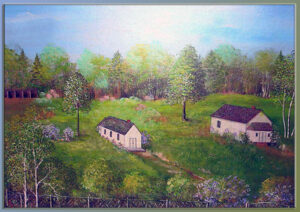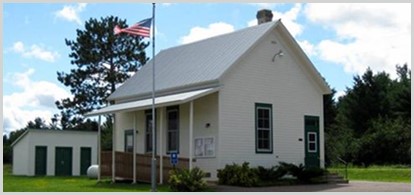History of the Town of Washburn, Wisconsin

Town of Washburn, Wisconsin
The Town of Washburn, created in 1884, was probably named for Cadwaller C. Washburn, governor of Wisconsin from 1872-1874 and founder of Gold Medal Flour. The original township included the present City of Washburn, but in 1904 the city was incorporated and the town formed its own government. O.L. Rowe was the first Chairman with Supervisors C. O. Dahl, J. Bartness, A.H. Hosmer, Clerk Allen Butterfield, and Assessor H.P. Swanby. Postal service began in 1883 under Postmaster F.E. Wyman.
When most of the timber had been cut and moved out of the area, there was a need for new opportunities. Land company agents promoted the agricultural potential of the area and many small farms were established through the 1920’s. Immigrants from Scandinavia and other European countries arrived during the late 1880’s through the early 1900’s in search of land, which was scarce in their homelands. Washburn reminded many of them of home. One of the earliest settlers to the current town was Erick Westling who came to the U.S. from Sweden in 1893, and after stays in Bibbon, City of Washburn, and Ashland, built a log cabin on Church Corner Road near Four Mile Creek around 1895. In 1897, he built a larger house and a dam to power a sawmill to make rough-cut timber planks and boards. Some of the pre-1905 families who thrived in this town were the Swansons, Andersons, Streckers, Days, Hoves, Pajalas, Flonnes, Cooks, Stones, and Tranmals. Some of these families walked miles daily to go to work and high school in the nearby City of Washburn.
In 1904, a fire raged through the countryside destroying bridges and trestles on the railway grade, necessitating the town to build new roads, mostly straight up and down the hills. The Westlings built a new, larger dam nearer the house and produced cedar shingles. The dam was removed in 1985 after a long battle to exempt it from DNR regulations.
Another historic Town site was developed in 1909 when the Betania Evangelical Lutheran Church was built at the northeast corner of Church Corner Road and Wannabo Road by the families of the area: Prestgard, Hirsch, Bergquist, Overby, Moland, Berge, and Anderson. A stable and Grange Hall were also built there. After the church was torn down in 1932, the Grange Hall was moved and torn down and became the Progress School on the corner of Nevers and Chequamegon Roads. Only four graves remain on the corner, including Beret Hove.
In 1922, the Town garage had its’ first motorized equipment. Electricity first came to the town by power line in 1929 by LSDP, but few people had power until the Bayfield Electric Coop established better lines in 1941. One of the earliest retail businesses was a store and dance hall on the east end of Long Lake by the Harvey family. In the 1930’s, the Topside (later moved to Barksdale) and C- Side taverns were established.
Farming became the main occupation of the folks who lived in the Town up through the 1930s. Over the years new technology supported larger farms and many small farms were abandoned. The land where the National Forest now lies was particularly poor and most farms that were located in this area failed after one generation. In 1929, the Federal Government purchased these lands under the Weeks Act of 1911, and later proclaimed them part of the Chequamegon National Forest. Aldo Leopold studied sharp tail grouse in the Moquah Barrens here in 1930.
Meanwhile, the Civilian Conservation Corps (CCC) was established in 1933 to provide employment during the Great Depression and restore natural resources. The first CCC camp in Wisconsin was established on Ora Brinks home site on the far western edge of town in April 1933 and hundreds of young men from the camp planted rows of jack pine in an effort to restore the forest. They worked managing the forest, building roads, line survey and fire protection until 1941. No buildings remain on site, but a maintenance building was moved to the old A. Zifko farm on Engoe Road and the foreman’s house to an unknown location off Hwy. 13.
There were eight (8) one-room school houses in the town, which were named McKinley, Four Mile Creek, Three Switch, Long Lake, Arbutus, Wilson, Progress, and Maple Hill. The McKinley was built on County C in 1905 and used until 1939. Today McKinley School serves as the Washburn Town Hall. The town hall was upgraded with new lap-board siding and fitted with new replica windows in 2006. The Maple Hill and Wilson schools were moved to other locations in the Town. The remaining school buildings were razed and removed from their sites.
The population of the Town has fluctuated through the years, but has shown steady growth since the 1970’s. Many changes have taken place as the area has become favored for homes in a rural setting. Many old barns still dot the landscape but most are used for hobby farms now. Historic Potter’s Farm, named for the accomplished writer and lecturer Greta Largo Potter, is used as a retreat. The area is known for its many artists including painters, fiber crafters, musicians, soap makers, wood workers and others. The Town of Washburn remains blessed with much natural beauty and a wealth of natural resources. People are to varying degrees shaped by the land in which they live, and the character of the land in turn is shaped by the actions of the people. Knowledge about the community, the history and the land can help the Town residents become better citizens.
